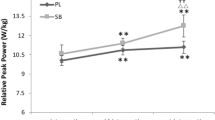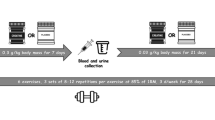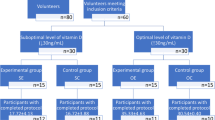Abstract
The aim of this study was to assess the effect of a daily intake of copper supplements on negative copper balance during prolonged exposure to hypokinesia (decreased number of kilometers per day). During hypokinesia (HK), negative copper balance is shown by increased, not by decreased, serum copper concentration, as it happens in other situations.
Studies were done during a 30-d prehypokinetic period and a 364-d hypokinetic period. Forty male trained volunteers aged 22–26 yr with a peak oxygen uptake of 66.4 mL/min/kg and with an average of 13.7 km/d running distance were chosen as subjects. They were equally divided into four groups: unsupplemented ambulatory control subjects (UACS), unsupplemented hypokinetic subjects (UHKS), supplemented hypokinetic subjects (SHKS), and supplemented ambulatory control subjects (SACS). The SACS and SHKS groups took 0.09 mg copper carbonate/kg body weight daily. The SHKS and UHKS groups were maintained under an average running distance of 1.7 km/d, whereas the SACS and UACS groups did not experience any modifications in their normal training routines.
During the 30-d prehypokinetic period and the 346-d hypokinetic period, urinary excretion of copper, calcium, and magnesium and serum concentrations of copper, calcium, and magnesium were measured. Copper loss in feces and copper balance was also determined. In both UHKS and SHKS groups, urinary excretion of copper, calcium, and magnesium and concentrations of copper, magnesium, and calcium in serum increased significantly when compared with the SACS and UACS groups. Loss of copper in feces was also increased significantly in the SHKS and UHKS groups when compared with the UACS and SACS groups. Throughout the study, the copper balance was negative in the SHKS and UHKS groups, whereas in the SACS and UACS groups, the copper balance was positive.
It was concluded that a daily intake of copper supplements cannot be used to prevent copper deficiency shown by increased copper concentration. Copper supplements also failed to prevent negative copper balance and copper losses in feces and urine in endurancetrained subjects during prolonged exposure to HK.
Similar content being viewed by others
References
M. G. Kolomiytseva and R. D. Gabovich, Trace Elements in Medicine, Izdatel’stvo Nauka, Moscow (1970).
L. P. Bushmeleva, Biological Trace Elements and Electrolytes and Their Significance in Medicine, Izdatel’stvo Nauka, Tomsk (1977).
V. A. Vorobyev, Metabolism of trace elements (iron, copper, zinc, aluminium, and silicon) in man and animals during acute bout and repeated exercise, Ph. D. thesis, Academy of Sciences USSR and Directorate of Sports Biology and Medicine, Ministry of Health, Moscow (1982).
A. P. Yurtseva, Changes in metabolism of iron, copper, cobalt, zinc and inactivity of metalloenzymes and their significance to the pathogenesis of diseases, Ph. D. thesis, Academy of Sciences and Directorate of Biology and Medicine, Ministry of Health USSR, Kiev (1975).
Yu. M. Bala and V. M. Lifshits, Trace Elements in the Practice of Internal Medicine, Izdatel’stvo Nauka, Voronezh (1973).
L. R. Nozdryukhina, N. I. Grinkevich, and V. I. Vorobyev, Endemic Diseases and Trace Elements, Meditsina, Kazan (1977).
A. P. Skoblin and A. M. Belous, Trace Elements in Bone Tissue, Meditsina, Moscow (1968).
Y. G. Zorbas, Y. E. Federenko, and K. A. Naexu, Blood plasma concentrations of microelements in endurance trained volunteers during hypokinesia and chronic hyperhydration,Biol. Trace Element Res. 41, 253–268 (1994).
Y. G. Zorbas, Y. F. Federenko, and K. A. Naexu, Urinary excretion of microelements in endurance trained volunteers during restriction of muscular activity and chronic rehydration,Biol. Trace Element Res. 40, 189–202 (1994).
J. V. G. A. Durnin and J. Womersley, Body fat assessed from total body density and its estimation from skinfolds thickness: measurements on 481 men and women aged from 16 to 72 years,Br. J. Nutr. 32, 77–97 (1974).
J. Brozek, F. Grande, J. T. Anderson, and A. Keys, Densitometric analysis of body composition: version of some quantitative assumptions.Ann. NY Acad. Sci. 110, 113–140 (1963).
I. V. Fedorov, V. N. Vinogradov, Y. I. Milov, and L. A. Grishanina, Synthesis of tissue proteins in animals during hypodynamia,Kosmicheskaya Biol. 4, 18–21 (1970).
I. V. Fedorov and L. A. Grishanina, Nitrogen metabolism in animals exposed to hypodynamia,Kosmicheskaya Biol. 1, 43–48 (1967).
I. V. Fedorov, A. V. Chernyy, and A. I. Fedorov, Synthesis and catabolism of tissue proteins during hypodynamia and resumption of muscular activity,Fiziol. Zh. SSSR 63, 1128–1133 (1977).
Y. G. Zorbas, G. E. Verentsov, and Y. F. Federenko, Renal excretion of end products of protein metabolism in urine of endurance trained subjects during restriction of muscular activity,Panminerva Med. 37, 109–114 (1955).
T. M. Lobova, Blood and tissue lipids in hypodynamic rats,Kosmicheskaya Biol. 7, 32–35 (1973).
Yu. P. Ryl’nikov, Hypokinetic effect on the lipid composition of blood and tissues of rabbits of different age,Kosmicheskaya Biol. 8, 8–13 (1974).
P. O. Potapov, “Glycosaminoglycans” (Mucopolysaccharide), collagen and lipids of tissues in the presence of hypodynamia, Ph. D. thesis, “Interkosmos” Council, Academy of Sciences USSR and Directorate of Cosmic Biology and Medicine, Ministry of Health, Moscow (1978).
Yu. V. Gusevas and R. Yu. Tashpulatov, Effect of 49-day cosmic flight on parameters of immunological reactivity and protein composition of blood in the crew of Salyut-5,Kosmicheskaya Biol. 13, 3–8 (1979).
Yu. V. Gusevas and R. Yu. Tashpulatov, Effect of cosmic flight differing in duration on protein composition of cosmonauts’ blood,Kosmicheskaya Biol. 14, 13–17 (1980).
Y. G. Zorbas, M. N. Yaroshenko, O. L. Georgeascu, and M. N. Tanaka, Haemoglobin mass in men after hypokinesia and physical exercise with chronic hyperhydration,Model. Simul. Control 21, 43–56 (1989).
Y. G. Zorbas, M. N. Yaroshenko, and Y. E. Federenko, Chronic hyperhydration and haematological changes in trained subjects during prolonged restriction of motor activity,Acta Astronaut. 36, 231–237 (1995).
Y. G. Zorbas, Y. F. Federenko, and K. A. Naexu, Renal excretion of magnesium in rats subjected to prolonged restriction of motor activity and magnesium supplementation,Magnes. Bull. 16, 64–70 (1994).
Y. G. Zorbas, Y. F. Federenko, and Ch. N. Saito, Endogenous parathyroid hormone and renal excretion of magnesium in endurance trained volunteers during prolonged restriction of muscular activity,Magnes. Bull. 16, 104–112 (1994).
P. A. Deuster, E. Dolev, S. B. Kyle, R. A. Anderson, and E. B. Schoomaker, Magnesium homeostasis during high-intensity anaerobic exercise in men,J. Appl. Physiol. 62, 545–550 (1987).
H. C. Lukaski, W. W. Bolonchuk, L. M. Klevay, D. B. Milne, and H. H. Sandstead, Maximal oxygen consumption as related to magnesium, copper and zinc nutrients,Am. J. Clin. Nutr. 37, 407–415 (1983).
Author information
Authors and Affiliations
Rights and permissions
About this article
Cite this article
Zorbas, Y.G., Charapakin, K.P., Kakurin, V.J. et al. Daily copper supplement effects on copper balance in trained subjects during prolonged restriction of muscular activity. Biol Trace Elem Res 69, 81–98 (1999). https://doi.org/10.1007/BF02783861
Received:
Accepted:
Issue Date:
DOI: https://doi.org/10.1007/BF02783861




